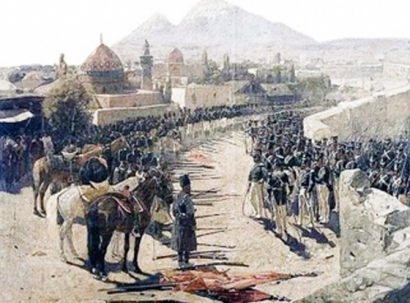Attempts to create an Armenian state in Karabakh in early XIX century

The primary objective of the Russian empire with regard to the expansion in the South Caucasus region at the beginning of the 19th century was to thwart Agha Mohammad Khan Qajar’s troops to take the region, including North Azerbaijan. In the same way, Russia could carry out the policy of hegemony in this region by seizing the Karabakh, Erivan and Nakhchivan khanates, and set up insuperable barriers at the Turkey-Iran border. By playing on the religious difference, Russia accordingly aimed to counterbalance the Ottomans and Qajarian Iran and create a pillar as an “Armenian state” in the Caucasus. It's probably not a coincidence that the Russian historian R. Kovalevsky acknowledged that Pavel Dmitriyevich Tsitsianov, who was sent to conquer the Caucasus territories, was tasked to implement imperial Russia’s plan through paying special attention to Armenians, protecting them, and using them as a lever.
The independent Azerbaijani khanate was placed under Russian overlordship with the signing of the Kurekchay contract between the Karabakh Khanate and Russian empire on May 14, 1805. To consolidate the imperial authority in Karabakh, Tsitsianov embarked on resettling Armenians in the South Caucasus.
By 1823, the total number of the population in the province grew to 4,366 families due to the resettlement of the Armenian families in Karabakh. As this fact, however, appeared insufficient for the Russian empire, the process marked the beginning of mass resettlement of Armenians in the territory of Azerbaijan, including in Karabakh.
In line with paragraph 15 of the Treaty of Turkmenchay, the Russian empire, began to massively resettle the Armenians from Iran in North Azerbaijan, largely in territories of the former Karabakh, Erivan and Nakhchivan khanates in the interest of the realization of its plan.
With this bloody policy, the Russian empire intended to create an Armenian state in the ancient Azerbaijani lands in the future. Russian authors, in fact, do not deny this unscrupulous policy.
To assist in transferring poor Armenian families, the Russian empire’s treasury allocated 25 thousand roubles by silver. Lazarev and his subordinate Armenian officers’ duties were limited to taking newcomers up to the border. The Committee created at the Interim Erivan Administration was tasked to direct this work later on. The Committee sent representatives to the border to meet the newcomers, and they accompanied them to their new settlements. Prince Abkhazov, chief of the military-custom district, was responsible for the resettlement of the newcomers. In early 1828, prince Abkhazov placed 750 Armenian families in Barda, a city in Azerbaijan. On December 24, 1829, Colonel Lazarev in his final report on the results of resettling Christians in Russia, addressed to Count Paskevich-Erivansky, the commander of the Russian troops in the Caucasus specified that the transmigratory works began on the 26th of February, 1828 and were completed by June 11th, 1828. The Armenian colonel Gazaros Lazaryan had realized the bloody policy.
Thus, the policy of Armenians’ resettlement from Iran to the western territory of Northern Azerbaijan and Karabakh was the beginning of forcing the Azerbaijanis off from their ancestral lands and creation of the "Armenian state”.
Further developments once again proved that the Iranian Armenians had been resettled in North Azerbaijan to create a “new motherland” for them.
However, Armenians as a nation, at all times possessed a special skill to distort the historical truth to their favour, and they decided to take over the territory that had been Azerbaijani since time immemorial – Karabakh, and till today they do not step back from their heinous actions. For example, in 1805, Russia and the Karabakh Khanate, one of the states of Azerbaijan that was torn away at that time, concluded the Treaty of Turkmenchay. Under the Treaty, the Karabakh Khanate was placed under Russian overlordship. And Russia affirmed that the Karabakh Khanate would remain in the possession of Ibrahimkhalil Bey, and in the future in the possession of Karabakh khan’s successors. However, the Armenian historians, ignoring the real history, trying to deform the very notion of the Кurekchay Treaty, declare that the territory of Karabakh ostensibly belonged to the Armenians, and the treaty was concluded between the Armenians and Russia. Though resettlement of the Armenians from Iran and Turkey to Azerbaijan, particularly on the territory of the Karabakh Khanate, had begun many years later after the signing of the Кurekchay Treaty in 1805, namely in 1828.
In 1978, the Armenians of Nagorno-Karabakh marked the 150th anniversary of their resettlement in the region and erected a special monument on this occasion in the village of Margushevan, Aghdere region. To erase traces of the historical truth, the Armenian separatists in 1988 destroyed the monument, which pointed to the fact that Armenians were newcomers to Nagorno-Karabakh.
Historical facts prove that the indigenous population of Karabakh has been Azerbaijanis throughout history. The Armenians living on this soil nowadays are aliens, or rather a relocated ethnic group.
Guntekin Najafli
AND OTHER...
-
 Book “Fuzuli’s Creativity” by Mir Jalal Out in Jordan
Book “Fuzuli’s Creativity” by Mir Jalal Out in Jordan
The book “Fuzuli’s Creativity” by the famous Azerbaijani writer and literary scholar Mir Jalal, which tells about the works of the brilliant Azerbaijani poet...
-
 Yusif Vazir Chamanzaminli’s Creativity in the Israeli Literary Magazine
Yusif Vazir Chamanzaminli’s Creativity in the Israeli Literary Magazine
“Artikl”, the popular Israeli literary magazine, has posted in Russian an excerpt from the novel “In the Crossfire” by Yusif Vazir Chamanzaminli, the outstanding...









